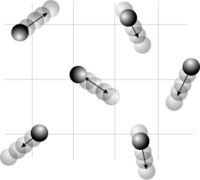Configuration integral

Have you ever played with building blocks and tried to figure out how many different ways you can arrange them? That's kind of like what a configuration integral is. But instead of building blocks, we're talking about particles like atoms or molecules.
When we have a bunch of particles, they can move around and switch places with each other. So, we want to know how many different ways we can arrange all of them. That's where the configuration integral comes in.
Think of it like a big book that has a bunch of different pages. Each page represents a different way we can arrange the particles. The book has so many pages that we can't possibly count them all by hand. But we don't need to because there's a special math trick we can use.
The trick is called integration. It's like adding up a bunch of tiny pieces to get the whole thing. So, instead of counting all the pages in the book, we can add up all the tiny pieces of each page to get the total number of ways we can arrange the particles.
This might sound complicated, but it's actually really helpful because it lets us make predictions about how particles will behave in different situations. For example, we can use the configuration integral to figure out how a gas will behave at different temperatures and pressures.
So, even though the configuration integral might sound like a big, scary math term, it's really just a way of figuring out how many different ways we can arrange particles. And that can help us understand how the world around us works!
When we have a bunch of particles, they can move around and switch places with each other. So, we want to know how many different ways we can arrange all of them. That's where the configuration integral comes in.
Think of it like a big book that has a bunch of different pages. Each page represents a different way we can arrange the particles. The book has so many pages that we can't possibly count them all by hand. But we don't need to because there's a special math trick we can use.
The trick is called integration. It's like adding up a bunch of tiny pieces to get the whole thing. So, instead of counting all the pages in the book, we can add up all the tiny pieces of each page to get the total number of ways we can arrange the particles.
This might sound complicated, but it's actually really helpful because it lets us make predictions about how particles will behave in different situations. For example, we can use the configuration integral to figure out how a gas will behave at different temperatures and pressures.
So, even though the configuration integral might sound like a big, scary math term, it's really just a way of figuring out how many different ways we can arrange particles. And that can help us understand how the world around us works!
Related topics others have asked about:
